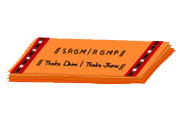Lyrics and Meanings (Padhams)
Padhams are scholarly compositions. The word, "Padha" was used to describe any "devotional song" in the olden days, but in recent times it is used to describe a particular type of musical form which belongs to dance repertoire.view more
Lyrics and Meanings (Padhams)
Padhams are scholarly compositions. The word, "Padha" was used to describe any "devotional song" in the olden days, but in recent times it is used to describe a particular type of musical form which belongs to dance repertoire. Though the padham belongs to the world of dance music, it is often sung in concerts (usually towards the end) because of its excellent musical quality. The sangītham(musicality) and Sāhithyam(lyrics) of the Padham are heavy. This form was perfected in the 17th Century by Kṣhethragna who is aptly called Father of the modern Padham.
The Padham has three sections: Pallavi, Anupallavi and Charaṇam, it is usually sung in a slower tempo. It may have three or more Charaṇams which are usually sung in the same tune, though they are textually different. The text deals with the concept of the "lover and beloved".
Padham brings out the relationship of Nāyaka-Nāyaki (hero and heroine) as well as thōzhi (close friend) explaining the joy, sorrow, and other feelings of love. They indirectly refer to god, since the Nāyaka is said to represent the “Paramāthma” (Great Soul, God), the Nāyikā(heroine) represents the Jīvāthma (human soul, man), and the thōzhi represents the guru (teacher), so the words of each is thought to help the audience reach mōkṣha (heaven).
In dance, Padhams give more importance to the Abhinaya part than footwork. But, unless the dancer inwardly feels the emotions, she cannot perform the Padham well. Each line of the song can be interpreted in many different ways. Karnātic music has hundreds of Padhams composed by poets and musicians and many of these have been rendered in dance. In Thelugu, padhams often have Lord Kriṣhṇa as the Nāyaka, while Tamil Padhams often have Lord Subramaṇya (Murugan) as their Nāyaka.
The first padhams in Sanskrit were composed by Vāsudheva Kavi who adorned the court of King Sarfoji of Tanjore. In the present days lyrics in Marāṭhi, Kannada and other languages are used for performing padham. However, in the olden days it was limited to Thelugu and Tamil only. And then there is the variety known as Kshethragna padham, which every artiste considers to be quite a challenge to execute. The verses of Kshethragna are set to slow rhythm but the emotions that are expressed in them are a bit too complex and a real challenge for the artiste to bring them out through sthāyi bhāva. If an artiste can perform to the verses of Kshethragna he or she can be considered to have mastered the art a great deal.
Most of the padhams are woven around God. Since the main theme of padham is the expression of feelings of the Nāyaki - estranged or otherwise - it can safely be concluded that the rasa would always be Śhrungāra and the God on whom the verse is written would always be in the male form.
| 1 | Chūḍare (Thelugu) | click here |












